Songbirds sing unique and complex tunes for several reasons, including to attract a mate, defend their territory, or strengthen their pair bond. You may be familiar with the musical notes of North American songbirds, especially on a beautiful spring morning. Discover 10 types of singing birds, along with their songs, timing, and habitats!
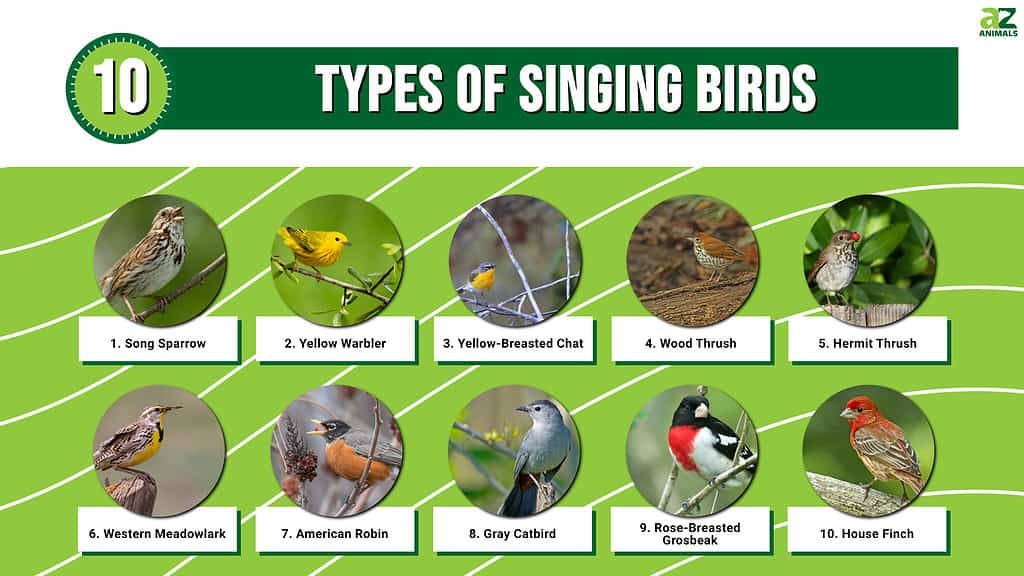
1. Song Sparrow
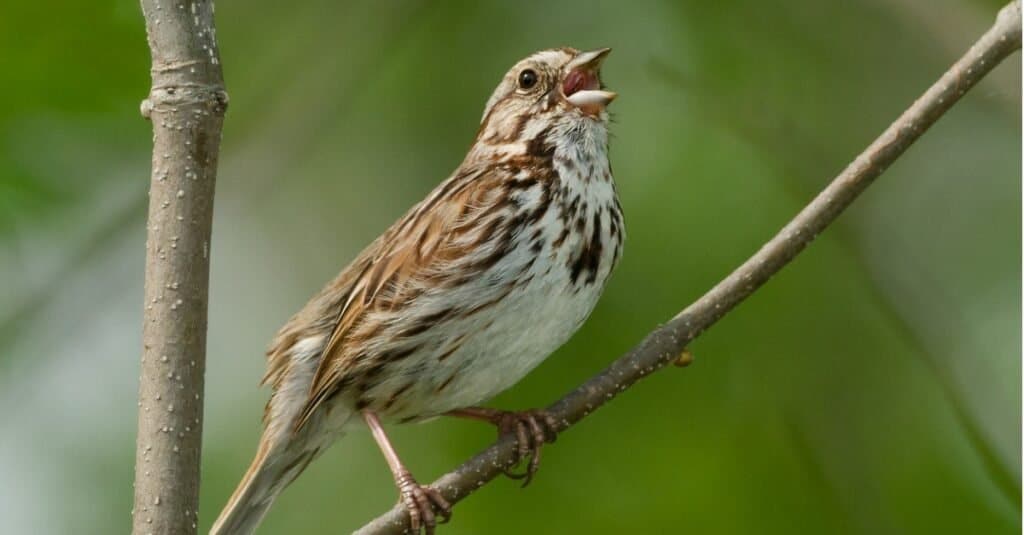
Song sparrows produce short, well-spaced notes ending in varying trills. They inhabit marshes, thickets, and gardens.
©iStock.com/PaulReevesPhotography
Songs: The song sparrow produces short, well-spaced notes (madge-madge-madge) and ends with varying trills or buzzes. These songs may not sound the same each time as they vary by singer.
Time of Day: They are most common around dawn in the spring. But it is not uncommon to hear song sparrows on cold winter mornings.
Habitat: They live in many open habitats, such as marshes, thickets, gardens, desert scrub, and grasslands.
Appearance: These medium-sized sparrows have round heads and long tails. They have streaky brown plumage with red and gray heads.
Backyard Tip: These birds enjoy bird baths and berry bushes.
2. Yellow Warbler
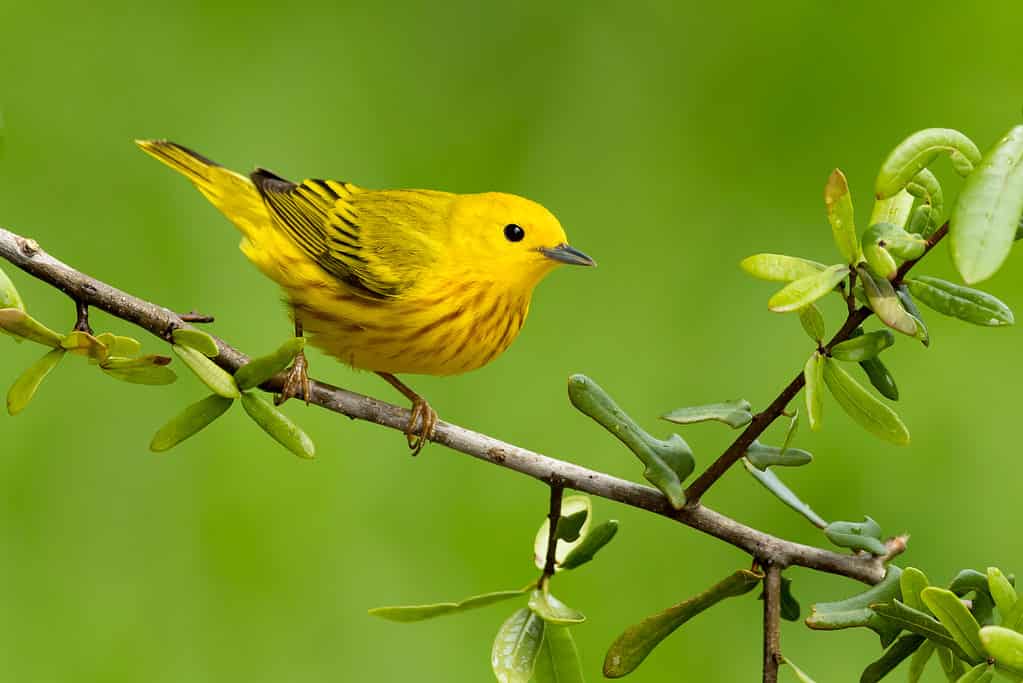
Yellow warblers have sweet, musical whistles. You will likely hear their sweet calls during early spring and summer mornings.
©Agami Photo Agency/Shutterstock.com
Songs: The yellow warbler sings a musical whistled song that sounds like “sweet-sweet-sweet, sweeter-than-sweet.” This phrase is often repeated at least 10 times per minute!
Time of Day: You will likely hear the yellow warbler’s sweet calls on early spring and summer mornings.
Habitat: This species lives in thickets, swamp edges, along streams, and in gardens. Willows are one of their favorite trees.
Appearance: These warblers are small and have rounded heads with stout bills. As their name suggests, they have bright yellow plumage with brown streaking.
Backyard Tip: You may find this bird in your backyard if you have small trees near a stream on your property.
3. Yellow-Breasted Chat
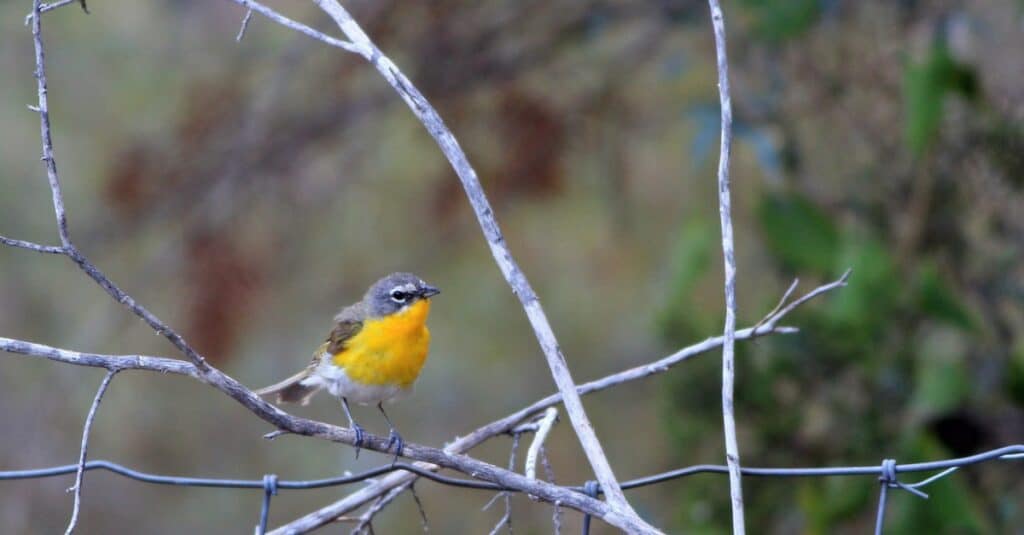
Yellow-breasted chats sing unusual songs featuring croaks, chuckles, and gurgles strung together in random phrases.
©iStock.com/Warren_Price
Songs: The yellow-breasted chats have a significant repertoire of croaks, cackles, whistles, chuckles, and gurgles, which they string together in random phrases. Their songs differ from typical warblers.
Time of Day: They sing during the mornings and evenings and may even sing at night during the breeding season.
Habitat: This species prefers dense habitats, like stream thickets, swamps, scrub, and briar tangles.
Appearance: These chats are larger and bulkier than other warblers and vireos. They have long tails and big heads and feature olive-green plumage above and bright yellow feathers below.
Backyard Tip: These birds are not common in backyards.
4. Wood Thrush

Wood thrushes have melodious, flute-like songs and can be found in mature forests near streams.
©iStock.com/Neil bowman
Songs: The wood thrush sings a melodious flute-like song with many variants. The middle phrase “ee-oh-lay” is easily recognizable. They also produce sharp call notes, like “pit-pit-pit.”
Time of Day: During summers in the Eastern United States, you can hear wood thrushes singing around dawn and dusk.
Habitat: They breed in mature deciduous and mixed forests, preferring damp habitats near streams.
Appearance: These thrushes have round bellies and short tails. Their plumage is warm reddish-brown above and white below with bold black spots.
Backyard Tip: They don’t come to feeders, but they may be audible if you live near a woodlot.
5. Hermit Thrush

The hermit thrush sounds like a flute when it sings. You can hear them early in the morning, well into the evenings.
©iStock.com/Wendy/Jeff Sparks/Torquemada
Songs: Hermit thrushes sing clear, musical phrases that begin with a piping whistle and end in soft, reedy echoes. They also sing a light whisper song in spring.
Time of Day: This species sings early in the morning and is one of the last to stop singing in the evenings.
Habitat: They live on forest floors in the interior. You can find them in boreal forests, deciduous woods, and mountain forests.
Appearance: This medium-sized thrush has a plump body, a round head, and a slender, straight bill. They are rich brown above and white below with dark brown spots. Their tails are warm red.
Backyard Tip: You may see the hermit thrush in your yard during migration if you have berry bushes.
6. Western Meadowlark
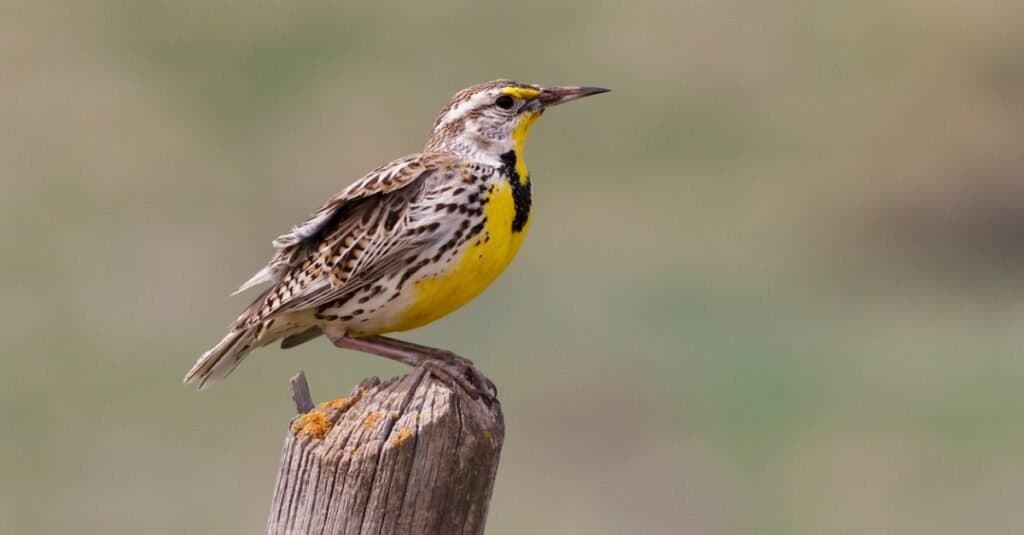
Western meadowlarks have complex songs of pure whistles and gurgling warbles. Listen for them all day, even at night.
©iStock.com/Gary Gray
Songs: Male western meadowlarks have a complex flute-like song of pure whistles and gurgling warbles. They have a large repertoire of 50 to 100 songs!
Time of Day: They sing at all times of the day during the breeding season, even during the middle of the night. But their songs are the loudest and most energetic early in the morning.
Habitat: The western meadowlark prefers open areas, like grasslands, prairies, agricultural fields, and meadows.
Appearance: This species is chunky and short-tailed with flat heads and long bills. They have streaky brown plumage above and bright yellow below with a distinctive black “V” on their chest.
Backyard Tip: These birds don’t typically visit feeders but may stop by open areas with perches and grass seeds.
7. American Robin
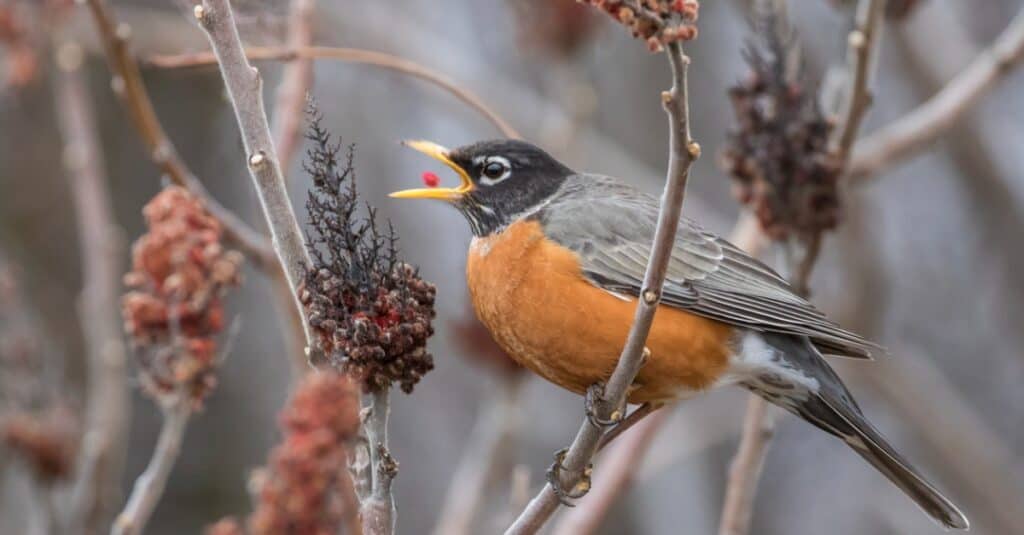
American robins produce steady rhythms of rich carols during spring and summer.
©iStock.com/mirceax
Songs: The American robin sings a steady rhythm of rising and falling rich carols, often described as “cheerily, cheer up, cheer up, cheerily, cheer up.”
Time of Day: The robin signals the beginning of spring and starts their songs an hour before sunrise, not finishing until after the sun goes down.
Habitat: This species lives in wide-ranging habitats, like fields, lawns, parks, woodlands, and forests.
Appearance: These large thrushes have round bellies, long legs, and long tails. They are dark grayish brown above and warm orange below, with white lower bellies.
Backyard Tip: American robins are common at backyard feeders. Provide them with chopped apples and mealworms!
8. Gray Catbird
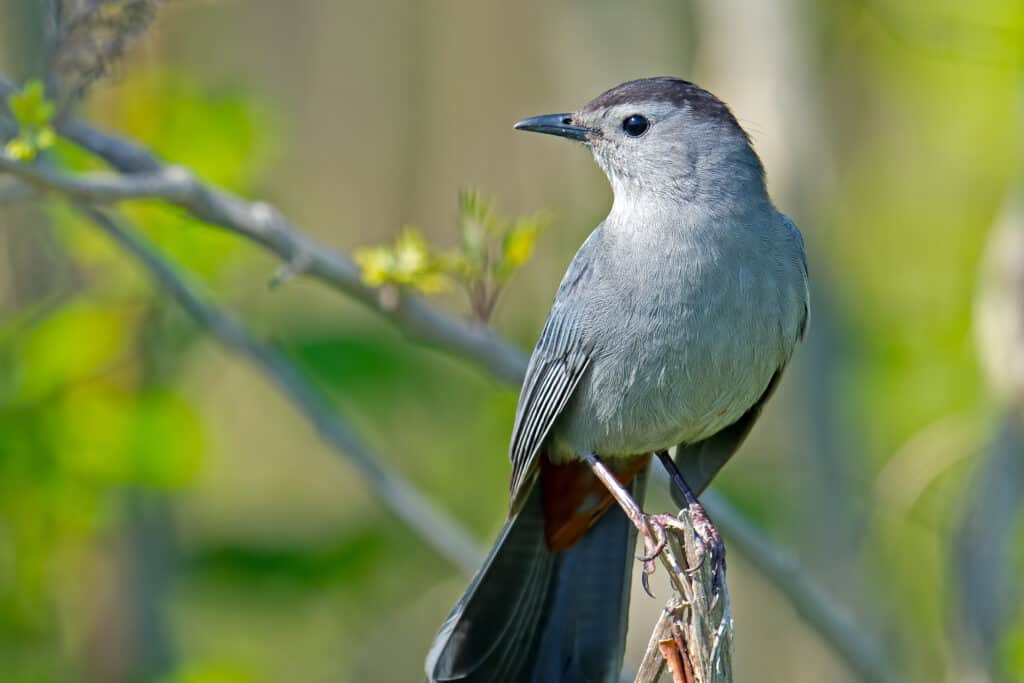
Gray catbirds sound musical and mechanical, like a cat mewing.
©Brian E. Kushner/Shutterstock.com
Songs: Gray catbirds sing a long series of short phrases, often sounding musical and mechanical, like a cat mewing. Their notes contain imitations of other birds and animals.
Time of Day: These birds sing throughout the day into the evening. But their songs are loudest during the morning.
Habitat: The gray catbird favors dense low-growth, such as shrubs, vine tangles, gardens, and thickets.
Appearance: These medium-sized songbirds have long tails and broad, rounded wings. They are entirely gray with small black caps and a rufous patch under their tails.
Backyard Tip: Plant native fruit-bearing trees and shrubs to attract these birds.
9. Rose-Breasted Grosbeak
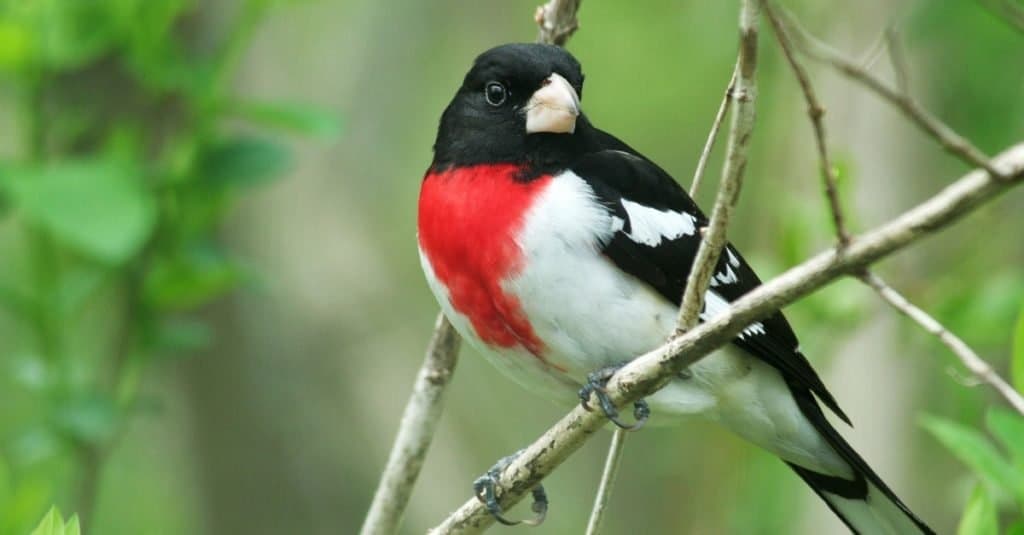
Rose-breasted grosbeaks sing soft, melodious whistles over 600 times a day during spring and summer!
©Jayne Gulbrand/Shutterstock.com
Songs: Male and female rose-breasted grosbeaks sing soft, melodious whistled songs. Their songs are very similar to an American robins’ song, except sweeter with more melody.
Time of Day: Males sing over 600 times a day during spring and summer. You can hear their tunes throughout most of the day.
Habitat: They live in moist deciduous and coniferous forests. But you can also spot them in orchards, groves, and thickets.
Appearance: Stocky and medium-sized, the rose-breasted grosbeak has a triangular bill and a broad chest. Males are black and white with bright red chests and pale bills.
Backyard Tip: They are frequent visitors to feeders and like sunflower seeds and peanuts.
10. House Finch
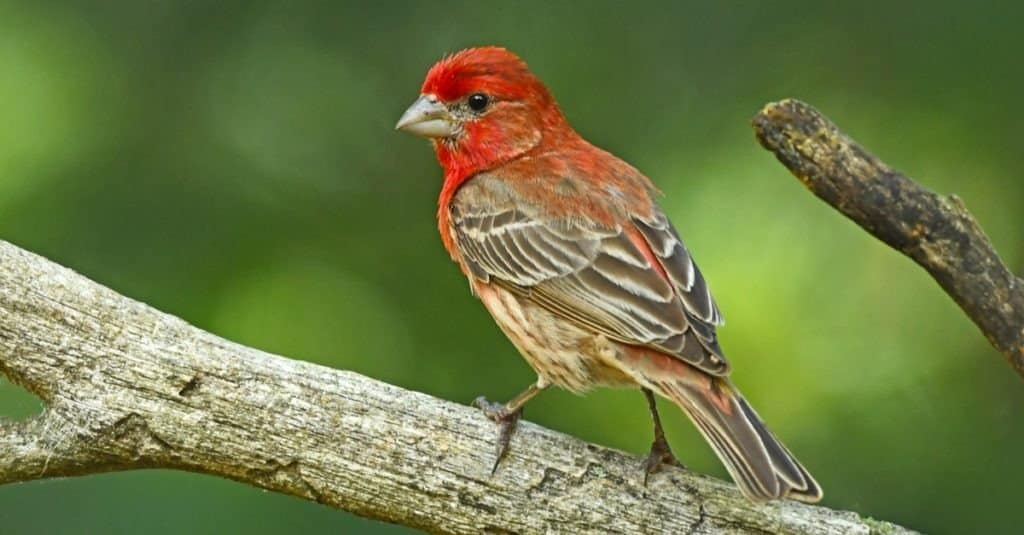
The house finch sings a series of short, jumbled warbles before the sun rises.
©Brian A Wolf/Shutterstock.com
Songs: The house finch sings a long series of short, jumbled warbles, ending in an upward or downward slur, “zeee.”
Time of Day: Their song can be heard throughout the day. Males sing a few hours before sunrise until a few hours before sunset.
Habitat: They live in many habitats, such as barns, lawns, cities, and towns.
Appearance: These small finches have conical bills and notched tails. They have rosy, red faces, and breasts with streaky brown backs.
Backyard Tip: This species is a common flocking bird at feeders. They particularly enjoy black oil sunflower seeds.
Summary of 10 Types of Singing Birds
Here’s a recap of the 10 wonderful singing birds that we took a look at.
| Number | Singing Bird | Song | Time of Day |
|---|---|---|---|
| 1 | Song Sparrow | Short, well-spaced notes ending with varying trills or buzzes | Most common around dawn in the spring; not uncommon to hear them cold winter mornings |
| 2 | Yellow Warbler | Musical whistled song | Early spring and summer mornings |
| 3 | Yellow-Breasted Chat | Repertoire of croaks, cackles, whistles, chuckles, and gurgles | Mornings, evenings, and may even sing at night during the breeding season |
| 4 | Wood Thrush | Melodious flute-like song with many variants and sharp call notes | Dawn and dusk during summers in the Eastern United States |
| 5 | Hermit Thrush | Clear, musical phrases that begin with a piping whistle and end in soft, reedy echoes | Early in the morning and is one of the last to stop singing in the evenings |
| 6 | Western Meadowlark | Males have a complex flute-like song of pure whistles and gurgling warbles | All times of the day during the breeding season; loudest early in the morning |
| 7 | American Robin | Steady rhythm of rising and falling rich carols | Starts an hour before sunrise, ending after the sun goes down |
| 8 | Gray Catbird | Long series of short phrases, often sounding musical and mechanical | Throughout the day into the evening; loudest in the morning |
| 9 | Rose-Breasted Grosbeak | Soft, melodious whistled song | Males sing over 600 times a day during spring and summer. |
| 10 | House Finch | Long series of short, jumbled warbles, ending in an upward or downward slur | Throughout the day |
The photo featured at the top of this post is © iStock.com/photographybyJHWilliams
Thank you for reading! Have some feedback for us? Contact the AZ Animals editorial team.






